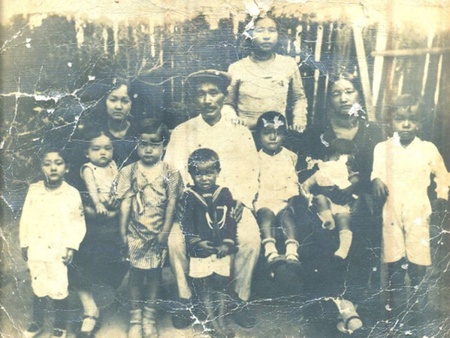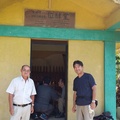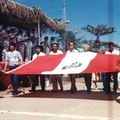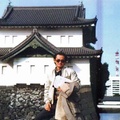Peru is a multiethnic, multiracial and multicultural country, so the Nikkei community in the country is equivalent to or constitutes a small proportion of that heterogeneous Peruvian population. From that perspective, there are surely many who have wondered or have concerns about their ancestral roots. Obviously, they will have some notions of the place or country of origin of their ancestors, but nothing more. In my case, I did not have the joy of knowing my father because he died when I was barely a year old and today, at 64 years of age, I just dared to investigate the origins or part of my father's history and those results Now we can share them thanks to Discover Nikkei, whose stories travel around the world, being very valuable for the entire Nikkei community.
The Ikedas of Madre de Dios-Peru have grown a lot and most, if not all, lack information about their roots and the worrying thing is that time moves forward, people are disappearing and with them part of the stories that interest us. or we should be interested. That was the motive that encouraged me to write this article, so that other members of the Nikkei community, including my relatives, can learn more about the family and perhaps we can exchange information or learn more about their past.
The Ikeda family, from Madre de Dios-PERU, comes from one root: the Japanese immigrant Kinsuke Ikeda, a native of Kagoshima, born on June 13, 1886. At the age of 22 he decided to cross the Pacific Ocean and have Peru as his destination, arriving at the port of Callao-Peru on the ship Carabelas on November 14, 1908. The address he registered upon arrival at the Japanese Embassy was: Kagoshima: Aira-gun. Kokube-mura.
My maternal grandparents: Toyokichi Yoshikawa (吉川豊吉), born on January 15, 1883, and Sono Yoshikawa, born on July 9, 1885, arrived in Peru on the ship Itsukushima Marú (seventh group of immigrants) on December 10, 1908. , with its address in Japan (Higashiuwa-gun Uonashi-mura). The young couple, 26 years old, made the long journey by boat, train and on foot to reach Madre de Dios. Shortly after, his first daughter, Yoneko, was born (09/17/1910) and then his other children, Hideko, Yosie, and Lorenzo.
Like many Japanese at that time, Kinsuke traveled to the Madre de Dios jungle to work, hired by the Inca Rubber Corporation to build the bridle path between the Tirapata railway station in Puno to a navigable point on the Tambopata River. When this work concluded, Kinsuke, among others, traveled to Puerto Maldonado and according to the Parish of Puerto Maldonado, on August 29, 1915 he was forced to be baptized by the Catholic religion, because he had to get married in the church and, as was customary in During those times, he was forced to acquire a Christian name and, as he was born on June 13 (according to the Catholic calendar, that day is celebrated to Saint Anthony), Kinsuke acquired the name Antonio Ikeda.
Once married, he traveled to Riberalta-Bolivia through the Madre de Dios River, remaining in that country for 11 years. He returned to Madre de Dios and married my mother YONEKO YOSHIKAWA in Puerto Maldonado- Madre de Dios, on October 25, 1926. From that union, today we constitute one of the largest families in this region, with around 250 direct members. (second, third, fourth and fifth generation Nikkei). Approximately 50% of them live in Japan as “dekaseguis” and are determined to remain in that country. For more than twenty years, Kinsuke provided river transportation services (the only means of transportation until 1945), together with his compatriot Sakae Koga.
At Christmas 2014 we had a family reunion, where what was interesting was the presence of the last five Ikeda brothers. The pending challenge is to try to reunite the entire family and, at the same time, establish our own organization under the name of Association, which will allow the family to be unified because the fourth and fifth generation relatives, in many cases, do not know each other. .
Many times we have asked ourselves if we are the only IKEDA in Peru and little by little we discovered that there were others with the last name Ikeda in Lima, Huaral, Iquitos. But the curiosity to learn more about these families remained latent. The Japanese Peruvian Association of Peru-APJ, on the occasion of the celebration of the 114th anniversary of Japanese immigration to Peru, presented the “Pioneros” website, a database that has 18,727 records of immigrants who arrived in Peru during the period 1899-1923. To my surprise, there were not three Ikedas who arrived in Peru but 70 Japanese with that last name, coming on different dates, ships and from various Prefectures. Of this contingent, 44 were hired by the sugar estates of Lambayeque (Tumán estate: 2), La Libertad (Laredo estate: 2) and Lima (Paramonga estate: 9, Cañete: 20). Of the other 26 Ikedas, the database does not record where they went: possibly to the Peruvian Amazon for rubber exploitation work or other activities, and the questions increased to know if there was any relationship or kinship between them. Of the 70 immigrants with the surname Ikeda, 13 came from Kumamoto, 11 from Kagoshima, 12 from Fukuoka, 5 from Fukushima, 4 from Ehime, 4 from Okayama and smaller numbers from Kagawa, Saga, Nigata. Possibly, would the 11 Ikedas from Kagoshima (Kanezo, Kumajiro, Kunio, Muneuchi, Sheichi, Shinzo, Toemón, Sonosuke, Yohachi and Kinsuke) have some relationship with each other? We do not have an answer to this question and it remains an agenda or pending task to continue researching and publish a book one day.
When I met so many Ikeda migrants, I wondered why so many Ikedas, internally I said to myself: couldn't it be that my last name is very common in Japan as it happens in Peru, where surnames like Flores, Quispe, Sánchez, Rodríguez, García, Rojas, Gonzales, Chávez , Days, etc., are very popular? and indeed, thanks to the advances in telecommunications, and the work of Ramiro Planas from the Autonomous University of Madrid (“Japanese Surnames”) I was able to find that in Japan the 25 most common surnames are: Sato, Suzuki, Takahashi, Tanaka, Watanabe , Itoo, Nakamura, Kobayashi, Yamamoto, Katoo, Yoshida, Yamada, Saitoo, Sasaki, Yamaguchi, Matsumoto, Kimura, Inoue, Shimizu, Hayashi, Abe, Yamazaki, Ikeda, Nakajima, Mori. In other words, what I feared was true, the Ikedas are in 24th place and that would explain the large number of people with that surname who were interested in emigrating to Peru for work. The source consulted also points out that there are around 120,000 Japanese surnames, much more than in China, whose population is 10 times larger than in Japan, but there the surnames are only a few thousand.
But the matter does not end here, other questions arose such as: where do Japanese surnames come from? According to Professor Planas, until before the Meiji Era (1868), the use of surnames was restricted to members of the nobility or the military caste or famous merchants and farmers. On February 13, 1875, with the modernization and Westernization of the new Japan, the Meiji Era government passed a law that required all citizens to register with a single surname. As a result of this order, many Japanese adopted a surname for the first time.
Those who have researched the subject mention that most current Japanese surnames refer to elements of nature or the landscape, using (almost always in composition) terms such as field ( ta , -da ), mountain ( yama ), river ( kawa ), tree ( ki , or as a later element of a compound, -gi ), village ( mura ), center or middle ( naka ), water ( mizu ), well ( i ), island ( shima ), valley ( tani ) , fields or meadows ( no , hara ), pond ( ike ), stones ( ishi ), rocks ( iwa ), proximity ( -moto ), up ( ue , kami ), down ( shita , shimo ), headland or spit of land that extends into the sea ( saki ), marshy land ( numa ), coastline or beach ( hama ), branch ( eda ), mouth or mouth ( kuchi , - guchi ), bridge ( hashi ), fountain ( izumi ), large ( oo- ), small ( ko- , o- ), good ( yoshi ), tall ( taka ), wide ( hiro) , long ( naga ), old ( furu ), young ( waka ). For example, the Japanese term motorcycle is used in the meaning of "next to", "next to", "next to", and therefore surnames such as: Yamamoto, next to the mountain ( yama = mountain, mountain); Kawamoto, by the river ( kawa =river); Miyamoto, next to the Shinto temple ( miya = temple); Sakamoto, next to the slope; Hashimoto, next to the bridge or those who live next to the bridge, etc. IKEDA, therefore, comes from two elements: ike (pond), da (field) whose literal translation would be: flooded field for sowing or a place where sowing is done.
On the other hand, in Japanese history clans (social groups formed by a number of families descended from a common ancestor) are mentioned in such a way that in the clans of the feudal stage ( Myoji ) five clans appear, among others. Ikeda (clans of Japan: wikipedia):
- Ikeda Clan (Genji), (池田氏), descendants of the Seiwa Genji, without direct relationship with other Ikeda clans,
- Ikeda Clan (Iyo)-(伊予池田氏)- no direct relationship with other Ikeda clans,
- Ikeda Clan (Mino)- (美濃池田氏) - no direct relation to other Ikeda clans,
- Ikeda Clan (Sasaki) - (池田氏) - minor branch of the Sasaki Clan - without direct relationship with other Ikeda clans,
- Ikeda Clan (Settsu)-(摂津池田氏) -descendants of the Ki clan- without direct relationship with other Ikeda clans,
The matter is complicated because we do not know what relationship these clans had with my family. Could it be that my " otosan " comes from one of these clans? Who knows, it is a question without an answer, perhaps some Nikkei somewhere in Peru or in other parts of the world will be able to shed light on this dark labyrinth. The truth is that there was no relationship between these five clans.
© 2015 Santos Ikeda Yoshikawa








